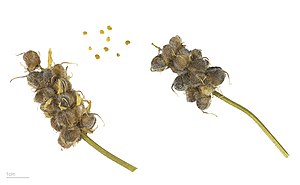Note: This is a project under development. The articles on this wiki are just being initiated and broadly incomplete. You can Help creating new pages.
Difference between revisions of "Astragalus gummifer"
(→External Links) |
|||
| (2 intermediate revisions by the same user not shown) | |||
| Line 8: | Line 8: | ||
==Chemical Composition== | ==Chemical Composition== | ||
| − | <ref name="chemical composition"/> | + | It contains different nutritional constitutes like moisture, ash and total acidity in methanolic extract of A. gummifer was detected. In proximate screening highest ratio of ash (35.1 ± 2.0 %) indicating a richest bio-resource of vitamins. While the values for moisture (13.5±1.10%) and total acidity (0.009±0.0001%) indicating its valuable properties.<ref name="chemical composition"/> |
==Common names== | ==Common names== | ||
| Line 63: | Line 63: | ||
==References== | ==References== | ||
<references> | <references> | ||
| − | <ref name="chemical composition">[ | + | <ref name="chemical composition">[https://biomedres.us/fulltexts/BJSTR.MS.ID.003387.php#:~:text=extract%20of%20A.-,gummifer.,%2C%20Cr%2C%20Cu%20and%20Ni. Chemical costituents]</ref> |
<ref name="Leaf">[Morphology]</ref> | <ref name="Leaf">[Morphology]</ref> | ||
<ref name="How to plant/cultivate">[https://pfaf.org/user/Plant.aspx?LatinName=Astragalus+gummifer Cultivationz]</ref> | <ref name="How to plant/cultivate">[https://pfaf.org/user/Plant.aspx?LatinName=Astragalus+gummifer Cultivationz]</ref> | ||
| Line 69: | Line 69: | ||
==External Links== | ==External Links== | ||
| − | * [ncbi.nlm.nih.gov/pmc/articles/PMC4395923/ Astragalus gummifer | + | * [https://ncbi.nlm.nih.gov/pmc/articles/PMC4395923/ Astragalus gummifer on ncbi.gov] |
| − | + | * [http://temperate.theferns.info/plant/Astragalus+gummifer Astragalus gummifer on the ferns.info] | |
| − | * [http://temperate.theferns.info/plant/Astragalus+gummifer Astragalus gummifer | ||
| − | |||
* [https://www.naturalmedicinefacts.info/plant/astragalus-gummifer.html Astragalus gummifer on natural medicine facts.info] | * [https://www.naturalmedicinefacts.info/plant/astragalus-gummifer.html Astragalus gummifer on natural medicine facts.info] | ||
[[Category:Herbs]] | [[Category:Herbs]] | ||
[[Category:Pages without herbs images]] | [[Category:Pages without herbs images]] | ||
Latest revision as of 17:41, 13 August 2020
Astragalus gummifer is a low-growing, thorny, deciduous shrub. This plant is one of the many species of Astragalus that produce tragacanth gum - a substance with many uses in medicine, as a food additive and in industry.
Contents
- 1 Uses
- 2 Parts Used
- 3 Chemical Composition
- 4 Common names
- 5 Properties
- 6 Habit
- 7 Identification
- 8 List of Ayurvedic medicine in which the herb is used
- 9 Where to get the saplings
- 10 Mode of Propagation
- 11 How to plant/cultivate
- 12 Commonly seen growing in areas
- 13 Photo Gallery
- 14 References
- 15 External Links
Uses
Parts Used
Gum.
Chemical Composition
It contains different nutritional constitutes like moisture, ash and total acidity in methanolic extract of A. gummifer was detected. In proximate screening highest ratio of ash (35.1 ± 2.0 %) indicating a richest bio-resource of vitamins. While the values for moisture (13.5±1.10%) and total acidity (0.009±0.0001%) indicating its valuable properties.[1]
Common names
| Language | Common name |
|---|---|
| Kannada | |
| Hindi | |
| Malayalam | |
| Tamil | |
| Telugu | |
| Marathi | |
| Gujarathi | |
| Punjabi | |
| Kashmiri | |
| Sanskrit | |
| English |
Properties
Reference: Dravya - Substance, Rasa - Taste, Guna - Qualities, Veerya - Potency, Vipaka - Post-digesion effect, Karma - Pharmacological activity, Prabhava - Therepeutics.
Dravya
Rasa
Guna
Veerya
Vipaka
Karma
Prabhava
Habit
Identification
Leaf
| Kind | Shape | Feature |
|---|---|---|
Flower
| Type | Size | Color and composition | Stamen | More information |
|---|---|---|---|---|
| {{{5}}} |
Fruit
| Type | Size | Mass | Appearance | Seeds | More information |
|---|---|---|---|---|---|
Other features
List of Ayurvedic medicine in which the herb is used
Where to get the saplings
Mode of Propagation
How to plant/cultivate
Requires a dry well-drained soil in a sunny position[1, 238]. Succeeds in poor soils.[3]
Commonly seen growing in areas
Dry sub-alpine slopes, Grassland, Dry valleys.
Photo Gallery
References
- ↑ Chemical costituents
- ↑ [Morphology]
- ↑ Cultivationz
External Links
- Ayurvedic Herbs known to be helpful to treat Tumours
- Herbs with Gum used in medicine
- Habit - Evergreen Shrub
- Index of Plants which can be propagated by Seeds
- Herbs that are commonly seen in the region of Dry sub-alpine slopes
- Herbs that are commonly seen in the region of Grassland
- Herbs that are commonly seen in the region of Dry valleys
- Herbs
- Pages without herbs images

